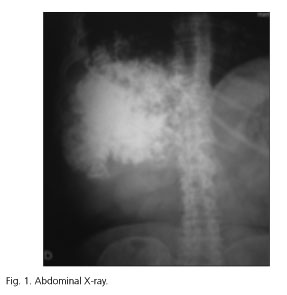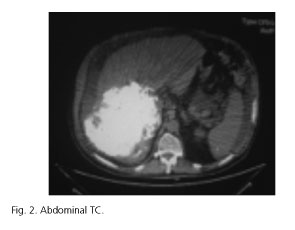Meu SciELO
Serviços Personalizados
Journal
Artigo
Indicadores
-
 Citado por SciELO
Citado por SciELO -
 Acessos
Acessos
Links relacionados
-
 Citado por Google
Citado por Google -
 Similares em
SciELO
Similares em
SciELO -
 Similares em Google
Similares em Google
Compartilhar
Revista Española de Enfermedades Digestivas
versão impressa ISSN 1130-0108
Rev. esp. enferm. dig. vol.109 no.5 Madrid Mai. 2017
PICTURES IN DIGESTIVE PATHOLOGY
Presentation of a malignant peritoneal mesothelioma in the form of rough hepatic calcifications
Calcificaciones groseras hepáticas como forma de presentación de un mesotelioma maligno peritoneal
Carmen Lara-Romero, Aida Casado-Bernabéu and Eduardo Romero-Pérez
Department of Digestive Diseases. Hospital Universitario Virgen de la Victoria. Málaga, Spain
The malignant peritoneal mesothelioma is a strange type of tumor that affects the peritoneal serosa, making up 10% of all mesotheliomas. Similar to the pleural mesothelioma, it is associated with industrial pollutants and asbestos, with a latency period of 30 years from exposure. There are no specific signs or symptoms, and it is usually diagnosed at an advanced stage. The most frequent symptoms are pain and abdominal distension, anorexia and weight loss. The localized form of the disease is less frequent and it usually presents itself as a heterogeneous intra-abdominal mass.
Case report
We present the case of a 60-year-old hypertensive male, without any other relevant medical history, who attended the Emergency Unit complaining about abdominal distension and asthenia for the past three months. On examination he presented an ascitic abdomen and what felt like a stony mass in the right hypochondrium. The chest X-ray showed a calcified mass on the right hypochondrium, without any other abnormalities (Fig. 1). The abdominal computed tomography (CT) showed a heterogeneous sub-phrenic mass, with calcifications that involved the right hepatic lobe (Fig. 2). Blood tests and tumor markers including alphafetoprotein were normal. The patient needed diuretics adjustments and several evacuative paracentesis during his stay in hospital in order to control the ascites. He had a positron emission tomography (PET) scan that showed a pathologic caption on the apical part of the voluminous tumor, with an important calcification and signs of hepatic infiltration on the right lobe. An exploratory laparoscopy was needed to achieve a histology sample, which finally gave the diagnosis: malignant peritoneal mesothelioma.
References
1. Teta MJ, Mink PJ, Lau E, et al. US mesothelioma patterns 1973-2002: Indicators of change and insights into background rates. Eur J Cancer Prev 2008;17:525. DOI: 10.1097/CEJ.0b013e3282f0c0a2. [ Links ]
2. Boffetta P. Epidemiology of peritoneal mesothelioma: A review. Ann Oncol 2007;18:985. DOI: 10.1093/annonc/mdl345. [ Links ]
3. Rodríguez D, Cheung MC, Housri N, et al. Malignant abdominal mesothelioma: Defining the role of surgery. J Surg Oncol 2009;99:51. DOI: 10.1002/jso.21167. [ Links ]
4. Estrada Saiz RV1, Loscos Valerio JM, García-Paredes J, et al. The role of laparoscopy in the diagnosis of primary peritoneal mesothelioma. Rev Esp Enferm Dig 1995;87(5):403-6. [ Links ]











 texto em
texto em 



